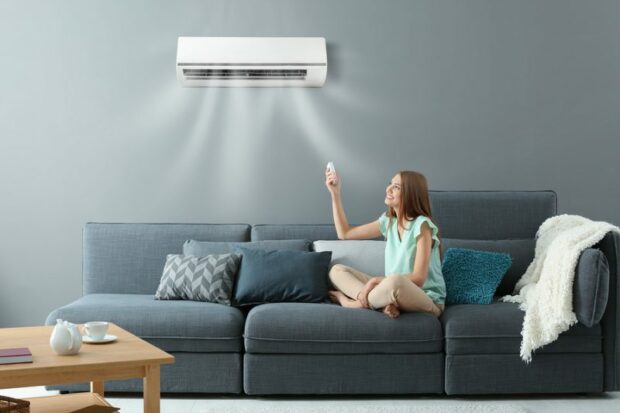Most minor HVAC repairs may cost you less than a hundred dollars, such as the $20 it takes to replace a condensate drain tube. However, major part repairs, such as an outdoor fan motor or condenser coil, can cost hundreds to thousands of dollars depending on your particular unit and area. The potential high end of air conditioner repair costs discourages many homeowners from seeking the help they need. Instead, they opt to run faulty, inefficient, or underperforming units until they completely break down. This isn’t the smartest move for your home, comfort, or financials considering there are plenty of ways to save money on your AC repair.

Sacrificing Comfort, Performance, & Safety Isn’t Necessary
In most homes, the HVAC is considered an essential of the same importance as running water and electricity. It’s an asset to your home that helps occupants feel comfortable. In some populations, proper temperature is even a necessity for your health and well-being.
Of course, AC’s with certain problems, such as faulty wiring, may cause a safety risk to your home and family. If your AC has wear and tear or malfunctioning parts, it’s likely to raise the cost of your energy usage and electric bill, too.
Your home is too important to risk its comfort, safety, and performance by avoiding budgeting for necessary professional services and repairs. According to https://airconditionersusa.
Don’t worry; we have some helpful tips to ensure that cost is as low as possible.
Tips To Get Quality, Low-Cost HVAC Repair
1. Look To Helpful Agencies
The Housing and Human Services Department’s free Heating Repair Replacement Program was established via a grant by the U.S. Department of Housing and Urban Development. The program may go by various variations of this name in different states. You can search through benefits.gov’s benefit finder for more information.
Such programs are designed to help moderate to low-income homeowners with the costs of repairing or replacing their main sources of heating and cooling. This may be full payment, or you may be responsible for a small percentage of the repair/ replacement cost. The government also offers other specialty programs, such as the Weatherization Program, to consider.
The Low Income Home Energy Assistance Program (LIHEAP) is a state-based program that helps low-income households with energy costs, energy crisis, weatherization, and energy-related home repairs. In most cases, if you qualify for SNAP, TANIF, or SSI benefits, then you automatically qualify for the program.
Municipalities also commonly offer their assistance programs, such as:
- Challenge funds
- 0% assist
- Loan deferment programs
- Senior, veteran, and other specialty stability grants
Speak to your local housing authority to find out more information about specific program availability in your area. Local HVAC repair companies also commonly keep a listing of local resources.
2. Don’t Skimp On Routine Maintenance And Service
When your AC seems to be working, it may be tempting to forgo routine maintenance and service. You may also ignore the warning signs of an impending breakdown.
It may save you a little money now, but it will likely prematurely age your unit and leave you with much more costly/major repairs in the future. Many areas, such as cleaning and replacing your AC filters, can be a DIY job.
However, it’s always best to get a full professional inspection at the end of each season. The pro will tell you how your unit has held up over the current season and any problems you might expect in the future. Any pressing existing problems can be quickly identified and repaired, which will ultimately improve the function, energy use, longevity, and cost of operation over the long-run.
3. Know Your Unit
Speaking of warning signs, you should take note of any changes you notice. This will enable the technician to address each concern individually and offer you a diagnosis and potential solutions. What to report:
- Strange noises
- Odd smells
- Room temperature fluctuations
- Liquid dripping, pooling, or overflowing from the unit.
- Dust and debris buildup in your home
4. Check Into Financing The Necessary Repairs
Most name-brand HVAC companies will work with at least one lender to offer a pay-as-you-go model. Individual big-box retailers also have their in-house financing options. Check to see if your electric company offers to finance for working with one of their preferred service members. There’s also the option of applying for a low to no interest credit card to finance your purchases for x amount of time free of interest and fees.
5. Brand Incentives
Should you have to replace or upgrade your unit because it’s simply too costly or in too bad disrepair to warrant investing more money in it, then you might want to consider brand incentives and rebates associated with the purchase. In many cases, you can stack all of the above for a great deal on a new energy-efficient model. Your air conditioning pro will be able to tell you more details.
6. Look At The Age, Condition, & Cost-To-Value
A tremendous amount of past repairs, even if minor, may indicate that the unit’s value isn’t as high as its repair costs are growing. The same can be said of even a single major repair for an aged AC.
Once you call your air conditioner technician, they’ll examine the unit and tell you what’s causing the symptoms. From there, you can compare costs in fixing versus replacing the unit.
As you weigh your options, ask yourself how old the unit is and its overall condition? Your technician will be able to give you a condition status on other major and minor parts of the system. Is it prudent to devote more money to a sinking ship, or can you get more life out of your AC if you repair it?
If your AC is over 10 years old, then obsolete technology and high costs to repair may mean its cheaper to purchase verses anew repair your existing HVAC.
You should consider a new unit anytime the repair cost is above 50% of the replacement cost.
Do keep in mind that energy savings from improved efficiency alone will offset the cost of both repair and replacement.
An Ounce Of Prevention: Cut Your AC Repair Costs With A Proactive Mindset
In closing, you can see that there’s a lot of wiggle room in the costs of repair and replacement if you’re already facing it.
Scheduling routine maintenance may seem like a wasted expense. If the air conditioning is working at all, it may seem like a good idea to wait for a complete breakdown. However, you should keep in mind that doing either place undue stress and work on your system can turn minor maintenance and repairs into major ones.
So, the ultimate tip is to keep those regular checkups and call your pro at the first sign of trouble to keep from incurring even bigger expenses after the delay.



